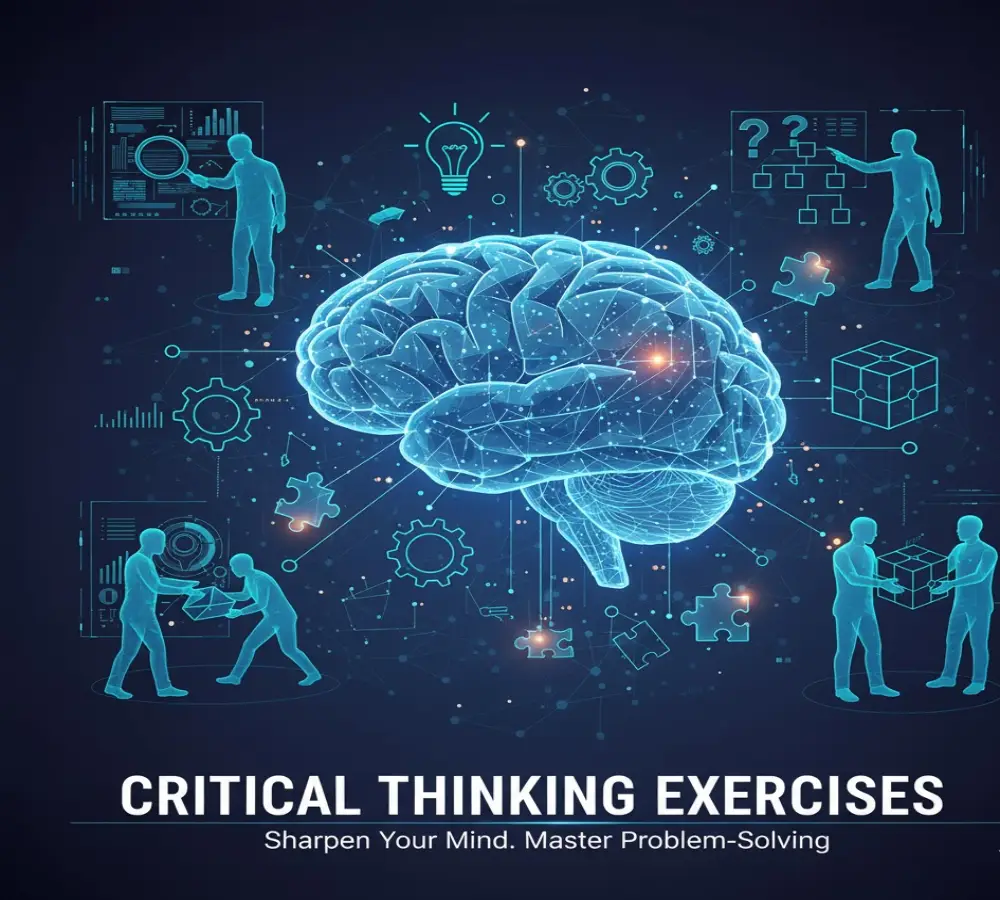In our current day society, critical thinking is an important skill to have. In our current fast paced society, the ability to think critically is not just a skill, it is essential. An individual has the ability to dissect information, come to reasonable conclusions, and approaches challenges with confidence. Professionals and students and countless others can benefit from this skill to increase the levels of creativity and personal development. This skill can unlock things that have been previously unexplored and are just waiting behind the door.
Analytical skills are just the starting point and can be built off of with practice. In this article, we will explore ten powerful critical thinking exercises that can help you develop sharper reasoning, and better problem solving abilities for a better perspective on the challenges you are facing.
What is Critical Thinking?
Critical thinking is the ability to objectively analyze each aspect and details, then fact evaluate and develop an accurate rationale. It goes beyond just bad memorization, and we feel it is bad to just look at opinions and not question them. Instead, it requires digging deeper for answers the question may help one obtain rather than stay on the surface by accepting things and walking away. It goes deeper by considering the what, rather than just the “that,” critical thinking addresses challenges. It requires a balance and a intersection of creativity with logic and evidence backed rational thought.
There are so many benefits to completing critical thinking exercises. People will be get better at making decisions and have increased levels of creativity as well as improved forms of communication, and that’s just the start. The exercises are intended to be a brain workout to help people think and build mental strength. They help to build the ability to think differently and to be more flexible. They also build and stimulate resiliency over time in your mental thought and thought processes.
1. Mind Mapping for Problem Analysis
Mind mapping is a visual exercise that helps you organize thoughts, uncover connections, and see the bigger picture. Start with a central problem or idea, then branch out with related concepts, questions, and solutions. By visually representing relationships between ideas, you can identify patterns, prioritize tasks, and explore solutions that might otherwise go unnoticed.
2. Question Assumptions
One of the simplest yet most powerful critical thinking exercises is questioning assumptions. Begin by identifying a common belief or accepted practice and challenge its validity. Ask yourself why it exists, what evidence supports it, and whether alternative approaches could be more effective. This habit fosters intellectual curiosity and prevents you from accepting ideas blindly.
3. Socratic Questioning
Socratic questioning is a structured method of inquiry designed to explore complex issues deeply. It involves asking a series of open-ended questions such as “What evidence supports this?” and “What are the implications of this decision?” By engaging in this process, you develop a disciplined approach to reasoning and uncover insights that are often overlooked.
4. Analyzing Case Studies
Studying real-world scenarios and case studies is an effective way to practice critical thinking. Examine the decisions, strategies, and outcomes of each case. Ask yourself what worked, what failed, and why. This exercise allows you to apply theoretical knowledge to practical situations and develop problem-solving skills that are transferable across different contexts.
5. Practicing Mental Simulation
Mental simulation involves imagining the potential outcomes of different actions before taking them. This exercise strengthens foresight, planning, and risk assessment skills. Visualize scenarios step by step, consider alternative approaches, and weigh the potential consequences. Over time, this habit improves strategic thinking and decision-making confidence.
6. Engaging in Debates
Participating in structured debates encourages you to defend your viewpoint while understanding opposing perspectives. This exercise promotes active listening, sharpens reasoning skills, and enhances your ability to articulate arguments clearly. Debating also encourages intellectual flexibility, helping you adapt your thinking when presented with new evidence or compelling logic.
7. Reflection Journaling
Reflection journaling involves writing down your thoughts, decisions, and the reasoning behind them. This exercise allows you to evaluate your thought processes, recognize patterns, and identify areas for improvement. By reviewing past reflections, you gain valuable insights into how your thinking evolves over time, strengthening your self-awareness and analytical skills.
8. Brainstorming Multiple Solutions
Critical thinking thrives on creativity and exploration. Brainstorming multiple solutions to a single problem encourages divergent thinking and reduces cognitive rigidity. Aim to generate a variety of ideas, no matter how unconventional they may seem. Once you have a list, evaluate each option systematically to determine the most effective course of action.
9. Practicing Analogical Thinking
Analogical thinking is the process of drawing connections between seemingly unrelated concepts. By finding parallels between different fields or experiences, you can generate innovative solutions and approach challenges from new perspectives. This exercise enhances creative problem-solving and encourages flexibility in thinking.
10. Solving Logic Puzzles and Games
Engaging with logic puzzles, riddles, and strategic games is a fun and stimulating way to sharpen critical thinking skills. These activities challenge your reasoning, pattern recognition, and decision-making abilities. Regular practice with logic-based exercises strengthens cognitive agility and encourages methodical, evidence-based thinking.
Why Consistency Matters
Like any skill, critical thinking improves with practice. Regular engagement in these exercises not only enhances analytical abilities but also promotes cognitive resilience, better decision-making, and more effective communication. By integrating these exercises into your daily routine, you can cultivate a mindset that approaches challenges with clarity, creativity, and confidence.
FAQs About Critical Thinking Exercises
How often should I practice critical thinking exercises?
Practicing daily or several times a week is ideal. Even 10 to 15 minutes a day can produce noticeable improvements in reasoning and problem-solving skills over time.
Can these exercises improve professional performance?
Yes, critical thinking exercises enhance decision-making, strategic planning, and communication, all of which are highly valuable in professional settings.
Are these exercises suitable for beginners?
Absolutely. The exercises can be adapted to any skill level, starting with simpler tasks like journaling and gradually moving to more complex problem-solving and debates.
How long does it take to see improvement?
With consistent practice, most individuals notice enhanced clarity and reasoning skills within a few weeks. Long-term engagement can significantly strengthen cognitive agility and analytical abilities.
Conclusion
Being able to think critically and clearly is an ability that has the potential to really change your view on problem solving, decision making, and interacting with the world. If you practice the ten impactful exercises detailed in the previous sections, you will be able to analyze situations more effectively, think in a more complex manner, and be able to maintain a mindset that works well in complex situations. Being able to deeply think, problem solve, and question things is an ability that has many future rewards, so start now and be prepared to see and think in a whole new way.
For more engaging content and the latest updates, follow Bunk knot for insightful articles and fresh perspectives!
Also follow: mastodon.social/@bunkknot

